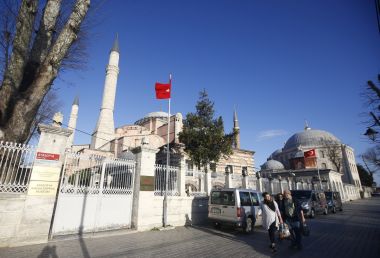Muslims Hide Christian Paintings In Former Church To Prevent 'Influence' During Worship

A former thirteenth century church in Turkey which has been converted into a mosque is being restored to include an electronic shielding system to conceal Byzantine-era Christian paintings during worship times.
Hagia Sophia Mosque in the Black Sea province of Trabzon is named after its better-known sister basilica in Istanbul, which also became a mosque and is now a museum.
The Trabzon church served a museum for 52 years but re-opened in 2013 as the Trabzon Center Mosque.
As part of the restoration, a shielding system which is used to cover mural paintings will be removed.
Instead, an electronic system will be placed in front of the walls to cover the paintings, according to the Hurriyet Daily News, which cited the state-run Anadolu Agency.
The restoration process is expected to cost 2 million Turkish Liras ($500,000) and will begin later this year.
The provincial director of foundations in Trabzon, İsmet Çalık said the mosque was a popular tourist attraction and described the process of blocking out the paintings.
"When we push the button, all mural paintings will become opaque...Thus, people will be able to worship without any influence from paintings," he said.
Çalık added that the mosque would remain open for worship."We aim to keep this mosque open during the restoration process," he said.
The former Hagia Sophia was built by the Byzantine Empower Manuel I Komnenos, a Christian crusader between 1238 and 1263.
According to Hurriyet: "When it was turned into a mosque following the Ottoman sultan Mehmed II conquering Trabzon in 1461, the frescos on the southern part of the building were whitewashed due to the Islamic ideology of not portraying religious iconography."
The former church is a renowned example of late Byzantine architecture, according to the Daily Sabah.
The original Hagia Sophia, the Church of Holy Wisdom, was founded in AD360 by the Byzantines. The current structure, one of the most remarkable church buildings in the world, was completed in AD 537 under Emperor Justinian. It was turned into a mosque after the Ottoman conquest of Constantinople in 1453 but was closed in 1931. It was turned into a museum in 1935 by the secular Turkish government, but under the increasingly Islamist government of Recep Tayyip Erdogan, nationalists have called for its re-opening as a mosque.











